|
|
Microstructure Design of Graphite in Nanoscale
CHUAN Xiu-Yun
2017 Vol. 32 (11): 1121–1127
 Abstract
Abstract(
1084 )
 HTML
HTML(
25)
 PDF
PDF(2288KB)(
1702
)
According to microstructural features of graphite, this paper reviewed the processing and dressing methods of graphite and proposed the nanostructured and functionalized engineering concept of graphite principally. The microstructure and properties of graphite could be modified and designed by using several approaches, such as introduction of nanoparticles by both synthesis of graphite intercalation compounds and preparation of graphite alloy. Active functional space for function particles could be induced by pore and porous structure formed through oxidation and activation. It is possible to synthesize graphene like flakes through exfoliation graphite and stripping layered structured graphite, to prepare the layer by layer functional materials. Due to the layered structure, graphite has strong anisotropic properties, which can be decreased by modification of flake direction and then becomes the isotropic graphitic functional materials. It suggests that microstructure design and nanostructured engineering in nanoscale can improve the properties of graphite, and obtain cheaper functional materials from natural graphite by characterization and nanostructure engineering, for wide potential applications, such as energy storage materials and graphene like materials.
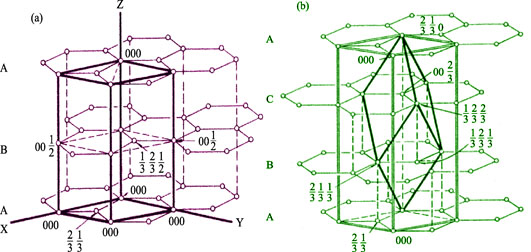
|
|
|
Hydrothermal Synthesis of Whitlockite
LI Guo-Chang, WANG Ping, LIU Chang-Bo
2017 Vol. 32 (11): 1128–1132
 Abstract
Abstract(
1365 )
 HTML
HTML(
51)
 PDF
PDF(688KB)(
2247
)
Whitlockite was firstly synthesized by a hydrothermal method using CaO, Mg(NO3)2 and H3PO4 as starting materials and then characterized by X-ray diffraction, scanning electron morphology, thermal analysis, and X-ray fluorescence. The variation of molar ratio of Mg/(Ca+Mg) in the precursor solution resulted in different crystallization behaviors of whitlockite during hydrothermal treatment. With the increase of the molar ratio of Mg/(Ca+Mg), crystal morphologies of products varied from hexagonal plate (about 30-50 μm) to spheres (about 3-5 μm) and cell parameters of a and c values decreased gradually. Meanwhile, the content of Mg/(Ca+Mg) in the products increased gradually and reached a high value of 13.6%. It was found that the nucleation and growth of whitlockite were almost completed within 2 h. Ca18Mg2H2(PO4)14 was transformed to Ca18Mg2(PO4)12P2O7 after calcination at temperature ranging from 680℃ to 950℃ due to the dehydration reaction.
|
|
|
Corrosion Behavior of SiCf/SiC Composites in High Temperature Fluoride Salt Environment
WANG Hong-Da, ZHOU Hai-Jun, DONG Shao-Ming, WANG Zhen, HU Jian-Bao, FENG Qian
2017 Vol. 32 (11): 1133–1140
 Abstract
Abstract(
1063 )
 HTML
HTML(
17)
 PDF
PDF(1238KB)(
2097
)
Corrosion behavior of SiCf/SiC composites, which were prepared via molten infiltration(MI), polymer impregnation and pyrolysis(PIP), and chemical vapor infiltration process(CVI), respectively, was studied by immersion in 46.5mol% LiF-11.5mol% NaF- 42.0mol% KF eutectic salt at 800℃. The evolution of phase composition and microstructure was characterized by X-ray diffraction and scanning electron microscope with energy dispersive spectrometer. The SiC matrix of SiCf/SiC composites, derived from different preparation process, has different compositions and microstructures, leading to various compatibility with fluoride salt at high temperature. Residual free Si in MI-SiC matrix and O-contained phase in PIP-SiC matrix are the weak area with worse corrosion resistance in liquid fluoride salt and will be corroded preferentially in terms of thermodynamic. Due to the higher purity and better crystallinity over the MI-SiC matrix and PIP-SiC matrix, CVI-SiC matrix shows more excellent compatibility with fluoride salt at high temperature and has the smallest corrosion rate of 0.0445 μg/(mm2·h). Least weak area confined to the O-rich boundaries between deposited layers may account for the good corrosion resistance of CVI SiC matrix.
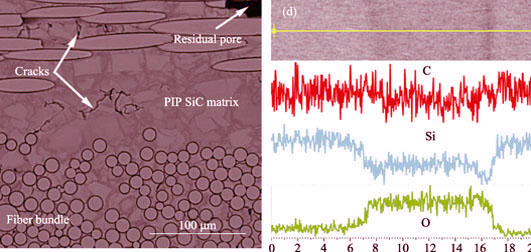
|
|
|
Ablation Behavior of (C-SiC)f/C Composites
ZUO Ya-Zhuo, LI Hong, WANG Shao-Lei, YANG Min, REN Mu-Su, SUN Jin-Liang
2017 Vol. 32 (11): 1141–1146
 Abstract
Abstract(
892 )
 HTML
HTML(
21)
 PDF
PDF(849KB)(
1835
)
(C-SiC)f/C preform was prepared by needle-punching technology, which SiC fiber felts and C fiber felts were laminated alternately. Then (C-SiC)f/C preform was densified by chemical vapor infiltration and impregnation with resin to prepare (C-SiC)f/C composites. H2-O2 flame ablation behavior of (C-SiC)f/C composites was investigated. Phase composition and microstructure of the (C-SiC)f/C composites before and after ablation were characterized by XRD, SEM and EDS, respectively. The results indicate that (C-SiC)f/C composites exhibit excellent anti-ablation resistance. After ablation for 750 s by H2-O2 flame, linear ablation and mass ablation rates of (C-SiC)f/C composites are as low as 1.88 μm/s and 2.16 mg/s, respectively. Compared with C/C composites, linear ablation and mass ablation rates of (C-SiC)f/C composites decrease by 64.5% and 73.5%, respectively. It is found that in the high temperature ablation process, the networking-shaped protective film formed by SiC fiber felts on the surface of the ablation center zone effectively protects materials from high temperature thermal damage. Molten SiO2 in the ablation transitional and marginal zone can heal cracks, holes and other defects, and effectively prevent oxidizing atmosphere into the materials, leading to excellent anti-ablation performance.
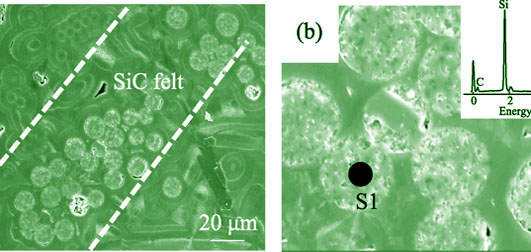
|
|
|
Relations between Needling Processing Parameters and Tensile Strength of C/C Composites
ZHENG Jin-Huang, LI He-Jun, CUI Hong, WANG Yi, DENG Hai-Liang, YIN Zhong-Yi, YAO Dong-Mei, SU Hong
2017 Vol. 32 (11): 1147–1153
 Abstract
Abstract(
722 )
 HTML
HTML(
14)
 PDF
PDF(1865KB)(
1589
)
The experiments for the fabrication of needling preform were designed according to response surface methodology (RSM) by the design-expert software to study effects of three variable needling processing parameters on the tensile strength of carbon/carbon (C/C) composites. Mathematical model between needling processing parameters and tensile strength of C/C composites was set up to optimize the needling processing parameters of preform and to predict the tensile strength of C/C composites. The mathematical model has good fitting degree with P-value of 0.0206 and the relative error between the predicted and the actual is no more than 10.82%. Based on the analysis of response surface of tensile strength, the needling depth has very significant influence and the needling density has significant influence on the tensile strength of C/C composites. The predicted scope of the tensile strength by the mathematical model is from 42.31 MPa to 91.87 MPa. The calculated optimal values are tensile strength 88.62 MPa, needling density 11 pin/cm2, needling depth 11 mm, and density of non-woven 50 g/m2, while the corresponding experimental result is 90.71 MPa with relative error 2.36%.
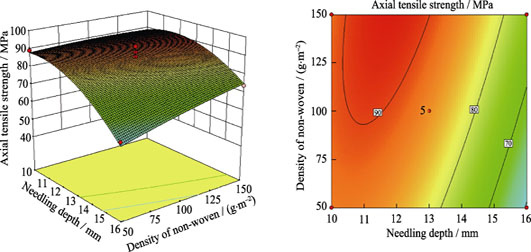
|
|
|
Silane Coupling Agent on Synthesis and Antioxidation Property of Zircon Film
CHEN Ting, ZHA Jian-Rui, ZHANG Xiao-Jun, JIANG Wei-Hui, JIANG Wan, LIU Jian-Min, WU Qian
2017 Vol. 32 (11): 1154–1158
 Abstract
Abstract(
885 )
 HTML
HTML(
18)
 PDF
PDF(1250KB)(
1571
)
The dense zircon film was prepared via Sol-Gel method using zirconium acetate and tetraethoxysilane as raw materials, and silane coupling agent 3-aminopropyltriethoxysilane (APTES) as surface modifying agent, respectively. Influences of APTES on the phase composition, morphology and antioxidation property of the ZrSiO4 film were investigated. The experiment results indicated that the pure and dense zircon film was achieved with addition of 10mol% APTES into ZrSiO4 sol. Once the molar ratio of APTES was beyond 10mol%, the impurity SiO2 was observed, and the viscosity of the ZrSiO4 sol increased significantly at the same time. AFM results showed that the smooth and dense film was obtained with APTES addition. After 102 h oxidation cyclic test at 1300℃, uncoated SiC substrate gained weight of 0.16%, while samples coated with ZrSiO4 thin films only gained weight of 0.08% and 0.03% before and after addition of APTES. In summary, APTES addition is beneficial for the density of ZrSiO4 thin film, resulting in excellent anti-oxidation property.
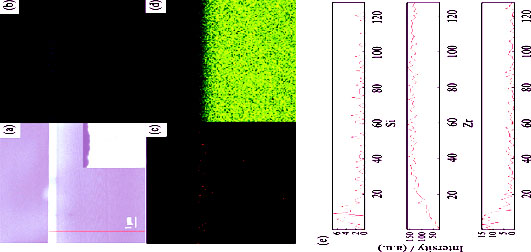
|
|
|
Carbon Aerogels Prepared Based on Sol-Gel Reaction of Cellulose Colloid with AEP and Its Adsorption of Copper Ions in Aqueous Solution
ZHENG Lei, LI Jin, LIU Hong-Bo
2017 Vol. 32 (11): 1159–1164
 Abstract
Abstract(
839 )
 HTML
HTML(
34)
 PDF
PDF(580KB)(
1737
)
A novel cellulose-based carbon aerogel with well-developed porous structure and surface group of hydroxyl was synthesized from cellulose aerogel by means of Sol-Gel reaction, freeze-drying and carbonization. In this preparation, cellulose was taken as carbon precursor and phosphate of polyoxyethylene isooctyl ether (AEP) was chosen as structure inducer of micelle in cellulose colloid. Thermal decomposition of the prepared cellulose aerogel was studied by TG technique; the properties of the prepared carbon aerogel, such as porous structure and function groups were characterized with SEM, N2 adsorption-desorption isotherms and Fourier-transform infrared spectroscopy (FT-IR). Adsorption of copper ion onto the test samples in aqueous solution was investigated through a static adsorption method. Results show that AEP can obviously regulate the porous structure and improve the adsorption performance of the prepared samples. The optimal sample of the prepared carbon aerogel possesses predominant pore structure of three-dimensional network, with a surface area of 655.4 m2/g and total pore volume of 0.73 cm3/g. The maximum copper ion adsorption capacity reached 86.27 mg/g in aqueous solution. In adsorption process, it is also found that the kinetics nicely follows pseudo-second-order rate expression, while the isotherm fits Langmuir model, displaying good adsorption properties. Therefore, the prepared carbon aerogel may have potential application in treatment of metal ion pollution in water. Meanwhile, the preparation strategies in this study provides a novel pathway for preparing carbon adsorbent with specific pore structure and functional groups on the surface.
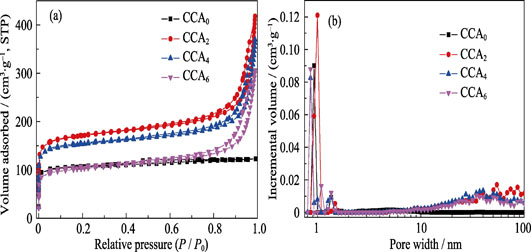
|
|
|
Preparation and Electrochemical Property of Polyaniline Coated Opal Shale/Sulfur Composite
CHAI Er-Ya, PAN Jun-An, YUAN Guo-Long, CHENG Hao, AN Feng, XIE Shu-Hong
2017 Vol. 32 (11): 1165–1170
 Abstract
Abstract(
719 )
 HTML
HTML(
24)
 PDF
PDF(956KB)(
1405
)
Opal shale/S composite was prepared by loading sulfur on opal shale via solution-based reaction- deposition method, and then polyaniline (PANI) was covered on the as-prepared opal shale/S composite by means of chemical oxidative polymerization method, which was used as cathode material of lithium-sulfur battery. Scanning electron microscope (SEM), transmission electron microscope (TEM), and Brunauer-Emmett-Teller (BET) characterization were conducted, and the results indicated that opal shale had a layered porous structure. As-prepared sulfur with small size was distributed uniformly in the composite. The PANI with around thickness of 400 nm was coated on the surface of the opal shale/S composite. Constant current charge-discharge tests showed that opal shale/S-PANI cathode obtained a maximum discharge specific capacity of 1164.93 mAh/g after activation and retained a discharge specific capacity of 539.30 mAh/g after 300 cycles at the current rate of 0.5C (1.0C=1675 mA/g). The coulombic efficiency of opal shale/S-PANI cathode always maintained more than 95%, indicating that opal shale with excellent adsorption properties and conductive PANI coating had double fixation effect for sulfur, which was beneficial to adsorb polysulfide and inhibit the shuttle effect.
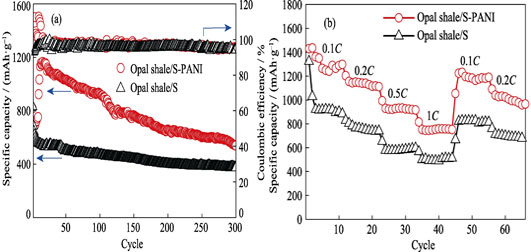
|
|
|
ThermoelectricProperties for CuInTe2-xSx (x = 0, 0.05, 0.1, 0.15) Solid Solution
QIN Yu-Ting, QIU Peng-Fei, SHI Xun, CHEN Li-Dong
2017 Vol. 32 (11): 1171–1176
 Abstract
Abstract(
1112 )
 HTML
HTML(
66)
 PDF
PDF(1146KB)(
2463
)
Diamond-like CuInTe2 compound has attracted great attentions recently as a new thermoelectric material. Despitethe considerable thermoelectric performance, the relatively high thermal conductivity at low and medium temperature ranges restricted further improvement of thermoelectric performance. Alloying was demonstrated an effective way to introduce mass and strain fluctuationsto lower the lattice thermal conductivity in several typical thermoelectric materials. In this work, CuInTe2-xSx (x=0, 0.05, 0.1, 0.15) solid solutions were fabricated by melting and annealing techniques. Phase purity and element distribution were examined by XRD and SEM-EDS measurements respectively. All the samples were pure phase and all the elements were distributed homogeneously. Callaway model was employed to analyze the thermal transport. It isfound that S substitution minimized the lattice thermal conductivity effectively, mainly due to extra phonon scattering induced by strain field fluctuation. However, itselectricalproperties were deteriorated by S doping, probably due to bigger band gap in CuInS2 than in CuInTe2.Therefore, if the electrical properties being improved by element doping, the CuInTe2-xSx (x=0, 0.05, 0.1, 0.15) solid solutions will achieve high thermoelectric performance.
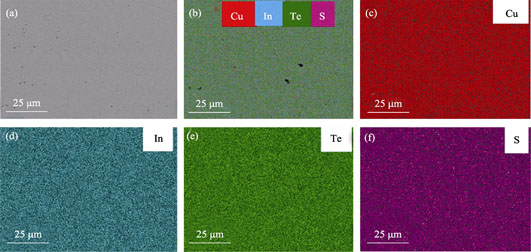
|
|
|
Quantitative Calculation of Thermal Conductivity of Tetragonal Phase and Grain Boundary on Zirconia Ceramics
ZHAO Wei-Wei, CHEN Xiao-Xin, LIN Chu-Cheng, SONG Xue-Mei, ZENG Yi, CHANG Cheng-Kang
2017 Vol. 32 (11): 1177–1180
 Abstract
Abstract(
1113 )
 HTML
HTML(
49)
 PDF
PDF(1302KB)(
1405
)
The yttria-stabilized zirconia (YSZ) coatings have been widely used as thermal barrier coatings (TBCs). In order to investigate the factors that influenced the thermal conductivity of TBCs, bulk YSZ ceramics with different grain sizes were prepared via hot-pressing sintering methods under different annealing conditions. The quantitative effects of the phase and the grain size on the thermal conductivity were analyzed. Based on electron backscatter diffraction images (EBSD) of YSZ ceramics, the distribution of grain boundaries and tetragonal phase were obtained. And thermal conductivities of grain boundaries and tetragonal phase were calculated by finite element models and Fourier’s equation. The thermal conductivities of grain boundaries and tetragonal phase are 2.65 W/(m·K) and 1.54 W/(m·K), respectively. The results reveal that the thermal conductivity of tetragonal phase is higher than that of the YSZ ceramic (2.31 W/(m·K)), while grain boundary’s is lower than that of the YSZ ceramic.
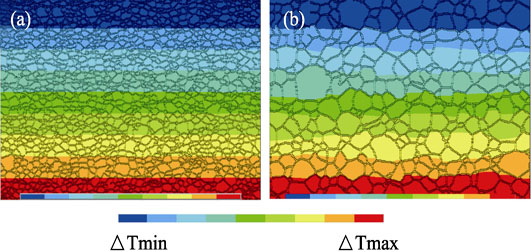
|
|
|
Preparation and Electrochemical Performance of Polyimide-based Activated Carbons with High Surface Area
WANG Hao, LI Lin, WANG Chun-Lei, WANG Qian, LIANG Chang-Hai, WANG Tong-Hua
2017 Vol. 32 (11): 1181–1187
 Abstract
Abstract(
917 )
 HTML
HTML(
17)
 PDF
PDF(746KB)(
1776
)
Polyimide-based activated carbon (PIAC) was prepared by CO2 activation using polyimide (PI) film offcut as precursor. The influences of activation conditions on the pore structure of PI-based activated carbons and the activation mechanism were investigated. Effects of pore structure on electrochemical properties of PIAC were also investigated. Results show that the PI film offcuts can be used to prepare the PI-based activated carbon with high surface area, abundant porosity and amorphous carbon structure at relatively low temperature via CO2 activation, in which the highest specific surface area was 2809 m2/g with pore volume of 1.423 cm3/g. Pore size and distribution of activated carbon can effectively be concentrated at 0.7-2 nm with proper mesopores by controlling CO2 activation time. As an electrode material, PIAC shows an excellent electrochemical performance with specific capacitance of up to 237 F/g at current density of 100 mA/g and capacitance retention of 86%.
|
|
|
Preparation and Electrochemical Performance of a Novel Perovskite Anode La0.9Ca0.1Fe0.9Nb0.1O3-δ for Solid Oxide Fuel Cells
ZHAO Xiao-Hong, WANG Yong, LIU Li-Min, Li Bin
2017 Vol. 32 (11): 1188–1194
 Abstract
Abstract(
655 )
 HTML
HTML(
16)
 PDF
PDF(1232KB)(
1501
)
The conventional Ni-YSZ anode as a cermet for solid oxide fuel cells (SOFCs) suffers from several shortcomings typically including low resistance to carbon coking, re-oxidation as well as sulfur poisoning. Perovskite anode as a potential substitute for Ni-YSZ anode has drawn much attention due to its impressive merits regarding carbon coking and re-oxidation resistance ability. In this study, a novel Nb-doped Fe-based perovskite anode candidate La0.9Ca0.1Fe0.9Nb0.1O3-δ was developed in which the addition of Nb greatly enhanced the structure stability in reducing atmosphere while the thermal expansion behavior was subtly influenced. The thermal expansion coefficient of the novel Nb-doped Fe-based perovskite anode changed from 11.67×10-6 K-1 to 11.57×10-6 K-1 after Nb doping while the electrical conductivity was greatly improved as well. At 800℃, the electrical conductivity of the novel Nb-doped Fe-based perovskite anode in H2 reached up to 1.95 S/cm. The cell with La0.9Ca0.1Fe0.9Nb0.1O3-δ anode prepared by infiltration method presented high electrochemical performance. The maximal power densities in H2 and CO at 800℃ were up to 539 and 491 mW/cm2, respectively. It is remarkable that the cell has impressive long-term stability in pure CO at 800℃ for as long as 200 h. The results indicate that the perovskite La0.9Ca0.1Fe0.9Nb0.1O3-δ material is electrochemically active for both H2 and CO oxidation which can be taken as a promising anode candidate for SOFCs practical applications.
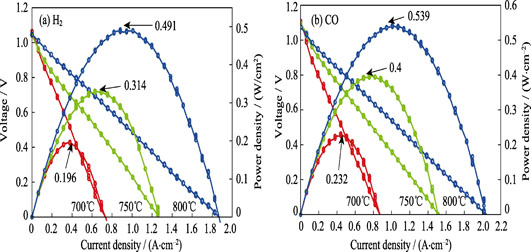
|
|
|
Reference Hydrogen Partial Pressure on Accurancy of Hydrogen Determination Utilizing Concentration Cell Type Sensor Based on Solid State Electrolyte
CHEN Jian-Xun, WU Shu-Sen, ZHANG Ya-Nan, MAO You-Wu, LÜ Shu-Lin
2017 Vol. 32 (11): 1195–1201
 Abstract
Abstract(
754 )
 HTML
HTML(
4)
 PDF
PDF(1884KB)(
1284
)
High temperature proton conductor CaZr0.9In0.1O3-α powders were prepared. By using the prepared powders, solid state electrolyte tubes were prepared. After assembling two types of concentration cell type hydrogen sensors, the effects of reference hydrogen partial pressures on electromotive force errors and hydrogen partial pressure calculation errors were investigated. At temperatures ranging from 873-1073 K and in the hydrogen partial pressure range of 0.005-0.1 atm (1 atm=1.013×105 Pa), the relative errors of electromotive forces increase when the hydrogen partial pressure difference between reference and measurement sides enlarged. This phenomenon is more obvious at low temperature of 873 K. The calculation error of the hydrogen partial-pressure according to the Nernst law is greatly dependent on hydrogen pressure ratio of the two sides of the cell. This error can be eliminated through reference hydrogen partial pressure at electromotive force of zero instead of hydrogen partial pressure. Hydrogen pressures platforms of β-ZrHx and δ-ZrHx coexistence zone were calculated by this method, as well as the formation enthalpy and formation entropy in the phases conversion process.
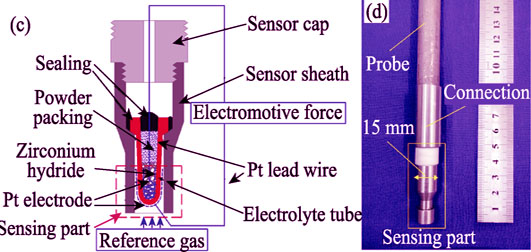
|
|
|
RGO/Bi2O2CO3: One-step Synthesis and Photocatalytic Property
ZHANG Guo-Ying, SHEN Xing-Qi, YANG Li-Ming, WEI Xue-Min, ZHANG Xin
2017 Vol. 32 (11): 1202–1208
 Abstract
Abstract(
851 )
 HTML
HTML(
8)
 PDF
PDF(986KB)(
1224
)
RGO/Bi2O2CO3 photocatalyst was prepared by one-pot hydrothermal method. The samples were characterized by XRD, N2 adsorption, XPS, SEM, and TEM. The results indicate that Bi2O2CO3 are effectively composited by the reduced graphene oxide (RGO). The photocatalytic property of RGO/Bi2O2CO3 composite is obviously improved after exclusion of physical adsorption from graphene. Specifically, the sample composited by 6.0wt% RGO shows the best photocatalytic activity with a rate constant as fast as 3.02-folds of Bi2O2CO3 for degradation of RhB. Photoelectrochemical analysis indicate that the introduction of RGO effectively inhibits the recombination of photogenerated e-/h+ pairs and broadens the visible light absorption of Bi2O2CO3. Mechanism exploration shows that more active species O2-· is produced due to the multi-site electron capture of O2 in the composite.
|
|
|
Imidazole and Nickel (II) Modified SAPO-34 and Its Catalytic Activity in CO2 Hydrogenation to Ethylene
TANG Xiao-Hua, LI Hui, YANG Ai-Mei, ZHA Fei, CHANG Yue
2017 Vol. 32 (11): 1209–1214
 Abstract
Abstract(
779 )
 HTML
HTML(
17)
 PDF
PDF(909KB)(
1400
)
Imidazole and nickel (II) modified SAPO-34 was synthesized according to the mass ratio of aluminum isopropoxide: phosphoric acid: silica sol: tetraethylammonium hydroxide : water : modified agents = 1.0 : 0.8 : 0.6 : 2 : 52 : 0.01. Specified amount of aluminum isopropoxide was mixed with distilled water and phosphoric acid was added to present the white homogenous gel. Tetraethylammonium hydroxide was Also mixed with specified amount of silica sol to form homogenous solution. The homogenous solution was added to the white homogenous gel. After stirring at 30℃ for 4 h, specified amount of imidazole and nickel nitrate (mole ratio = 1 : 1) was added in and kept at 60℃ with a constant stirring speed for 8 h to result in a semi-transparent homogenous white gel. The white gel was transferred into a high-pressure stainless steel autoclave and maintained at 200℃ for 24 h without stirring. As precipitate was recovered from the autoclave, it was dried at 120℃ for 12 h and calcined at 550℃ for 6 h to acquire imidazole and nickel modified SAPO-34. It was characterized by means of N2 adsorption/desorption, X-ray powder diffraction (XRD), scanning electronic microscopy (SEM), and energy dispersive spectroscopy (EDS). The modified SAPO-34 was mechanically mixed with CuO-ZnO-Al2O3 prepared by co-precipitation process to form composited catalyst (CZA/SAPO-34x). The activity of CZA/SAPO-34x for CO2 hydrogenation to light olefins was investigated in a differential fixed reactor. Under reaction pressure of 3.0 Mpa, temperature of 400℃, space velocity (SV) of 1800 mL/(gcat·h), volume ratio of CO2 to H2 of 1 : 3, and composited catalyst mass of 1.0 g, the one-way conversion of CO2 and selectivity of ethylene are 73.8% and 67.7%, respectively. Compared with SAPO-34, imidazole and nickel (II) modified SAPO-34 keeps high catalytic activity when reaction temperature rises to 450℃, showing the high temperature resistance.
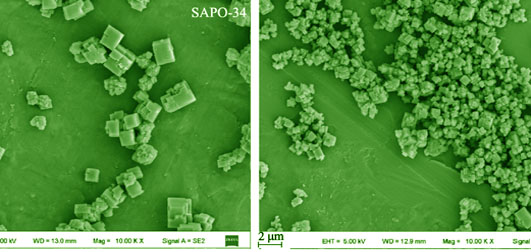
|
|
|
Porous Hydroxyapatite Microspheres Prepared by Using Poly (Allylamine Hydrochloride) and Its Application in Drug Delivery
MA Fang, CUI Ming-Fang, ZHU Jian-Hua, LI Ya-Li
2017 Vol. 32 (11): 1215–1222
 Abstract
Abstract(
995 )
 HTML
HTML(
11)
 PDF
PDF(1351KB)(
1794
)
Porous and hollow hydroxyapatite (HAP) microspheres were synthesized successfully in hydrothermal method utilizing poly(allylamine hydrochloride) (PAH) as the crystal growth regulator. Effects of reaction time and concentration of the polymer on the growth of final products were investigated. Uniform microspheres with dense pores can be synthesized by controlling the PAH concentration (0.3-0.5 g/L) after 12 h hydrothermal reaction at 150℃. Formation of hollow microspheres includes different stages of early precursor microstructures, heterogeneous nucleation and phase transformations. At different stages, the cationic polyelectrolyte PAH plays an important role in regulating growth of hollow microspheres. Ibuprofen (IBU) was chosen as a typical model drug to study the drug loading and the desorption ability. The results show that porous and hollow microspheres have relatively high drug loading capacity (413.65 mg/g). Drug release of the microspheres is favorably pH-responsive, which may have close relationship with the surface properties of HAP nanorods. Date from this study suggest that the porous microspheres will have potential application as the targeted-drug carrier in the biomedicine field.
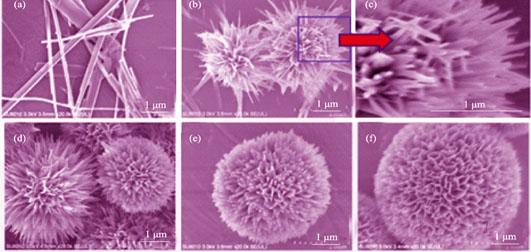
|
|
|
Interactions Between Bubble and Interface During KTa1-xNbxO3 Crystal Growth
LI Shu-Hui, PAN Xiu-Hong, LIU Yan, JIN Wei-Qing, ZHANG Ming-Hui, YU Jian-Ding, CHEN Kun, AI Fei
2017 Vol. 32 (11): 1223–1227
 Abstract
Abstract(
702 )
 HTML
HTML(
3)
 PDF
PDF(848KB)(
1631
)
The generation of bubbles and its interaction with the interface during melting and growth process of potassium tantalate niobate (KTa1-xNbxO3) crystals were visualized by a high temperature in-situ observation system. It was found that bubbles are generated mainly from the solid-liquid interface during melting, rather than from the melt. Bubbles with radii smaller than 0.7 $\overline{r}$ (where $\overline{r}$ is the mean radius of bubbles) arise mostly from nucleation at the interface while radii larger than 1.5 $\overline{r}$ are the result of coalescence. The existence of the bubble not only lowers the growth velocity of the near interface, but also affects the structure of the crystal. The effect of a bubble on the growing interface depends on their dimension ratio together with the moving speed of the interface. There are three typical kinds (hat-, sphere- and ellipsoid-shaped) of vapor inclusion morphologies being demonstrated. The analysis of the bubble behavior can promote the understanding of the formation of inclusion defects in KTN crystal growth process.
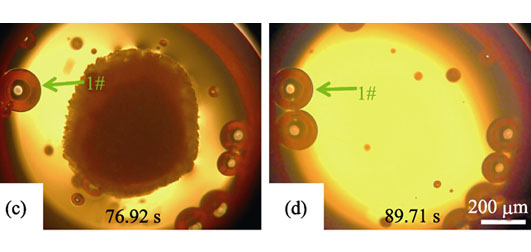
|
|
|
Boron Content on Microstructure and Mechanical Properties of Amorphous Boron Carbide by Chemical Vapor Deposition
QIAO Zhen-Jie, GAO Le, FENG Qian, HU Jian-Bao, DONG Shao-Ming, MA Liang-Lai
2017 Vol. 32 (11): 1228–1232
 Abstract
Abstract(
1007 )
 HTML
HTML(
14)
 PDF
PDF(541KB)(
1177
)
Boron carbide coatings BxC1-x (x=0.05, 0.10, 0.16, 0.30, 0.50) were prepared by low pressure chemical vapor deposition technique from BCl3-C3H6-H2 precursor mixtures. The effects of boron content on the microstructure and mechanical behaviors of the BxC1-x were investigated. The B0.1C0.9 coating displayed a graphite-like structure of high crystallinity where a large fraction of boron atoms exists as atomic substituent in the carbon layers. As boron content increased, the structure tended to be amorphous, because of the formation of increasingly numbers of B-C bonds. The B0.1C0.9 coating showed a low hardness and elastic modulus, and its mechanical behavior was close to that of an elastic soft film. The H and E of BxC1-x coatings were significantly enhanced at high boron content level, because of the formation of increasing amounts boron carbide in them.
|
|